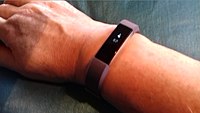
Photo from wikipedia
OBJECTIVES If consumer-based monitors such as Fitbit can measure activity accurately, it could provide opportunities for improved assessment of physical activity in general and at work for research purposes. The… Click to show full abstract
OBJECTIVES If consumer-based monitors such as Fitbit can measure activity accurately, it could provide opportunities for improved assessment of physical activity in general and at work for research purposes. The accuracy of the Fitbit has hardly been investigated in an occupational setting. METHODS We compared measurements of steps taken at work, out-of-work, and in total of a wrist-worn Fitbit to a waist-worn Actigraph. Seventeen participants wore the Fitbit and Actigraph for 1 full workday. RESULTS Compared with the Actigraph, the Fitbit consistently recorded more steps [mean steps at work Fitbit = 7850 (6974), Actigraph = 4396 (1991); out-of-work Fitbit = 6414 (5691), Actigraph = 4116 (3502); total Fitbit = 13 478 (10 666), Actigraph = 8009 (5167)]. CONCLUSIONS Compared with the Actigraph, the Fitbit consistently recorded more steps at work, out-of-work, and in total. The Fitbit and Actigraph recordings were more consistent for measuring steps taken out-of-work compared with at work. Steps counts recorded by the Fitbit, especially in occupational settings, may be inaccurate.
Journal Title: Annals of work exposures and health
Year Published: 2021
Link to full text (if available)
Share on Social Media: Sign Up to like & get
recommendations!